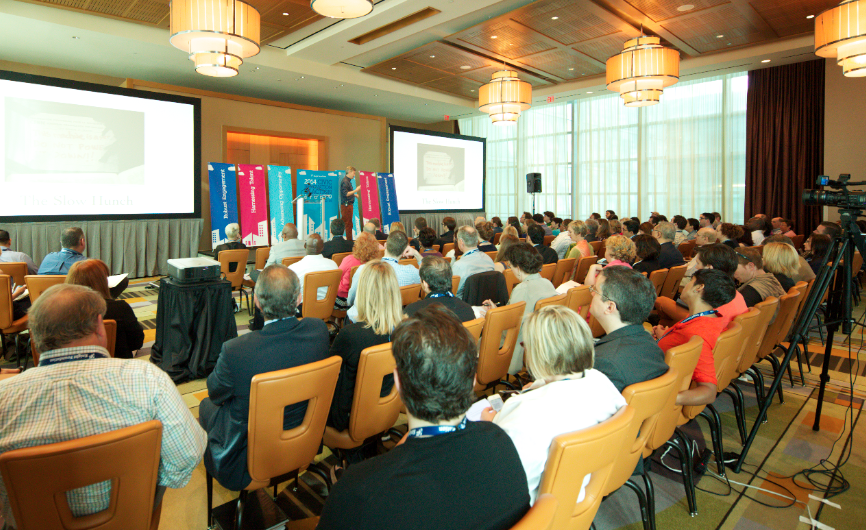
Studio developing ideas to harness talent of a changing workforce
Photo credit: Tom Clark.
Knight Foundation President Alberto Ibargüen opened Knight’s two-day Civic Innovation in Action Studio Tuesday by reminding participants of the foundation’s roots. Jack Knight’s aspiration for newspapers he said was essentially to provide people with the means “to determine their own interests.” RELATED LINKS
“Putting ideas into action to build better cities” by Carol Coletta on KnightBlog
“Learning Lab gathers ideas on promoting community engagement” by Carol Coletta on KnightBlog
“Learning Lab gathers ideas on making the most of talent in our cities” by Carol Coletta on KnightBlog
“Boston adopts new tools to engage residents in civic life” by Nigel Jacobs on KnightBlog
“Scaling an Etsy Economy for a changing workforce” by Dana Mauriello on KnightBlog
“Harriet Tregoning, identifying ideas to expand opportunities in cities” by Carol Coletta KnightBlog
“Encouraging more robuts acts of citizenship” by Adam Royalty and Scott Witthoft on KnightBlog
“Studio explores ideas for successful cities” by Carol Coletta on KnightBlog
“Civic innovators gather in Miami to build ideas for successful cities” by Michael Bolden on KnightBlog
“Innovators embrace broad themes of robust engagement” by Andrew Sherry on KnightBlog
“Innovators develop ideas on advancing opportunity” by Michael Bolden on KnightBlog
“This is an important thought to keep in mind as we engineer change in communities,” said Ibargüen.
Perhaps the most important determinant of individual interests is the work that people do. Yet communities are increasingly faced with an outdated employment system—stacked in favor of a 9-to-5, stable, low-risk work culture—that has since been disrupted. To tackle this challenge more than 30 civic innovators came together as part of the “Harnessing Talent” discussion on day one of the studio. Participants included government officials, human resources professionals, design and co-working experts, business executives, as well as consultants and freelancers.
Together they considered the demands posed by an increasingly mobile, tech-driven labor force that includes a growing number of independent workers, from self-employed tech consultants and freelancers to Lyft drivers and Esty makers crafting a new shared economy.
They explored several questions:
- Who is the target of a city’s economic development efforts if more than 20 percent of its workers are self-employed?
- What type of support do solo entrepreneurs need?
- How can public places and programming be used to make independent workers as productive as possible?
- What are the programs, platforms and policies needed to harness talent an expand opportunity in an economy with a workforce that is increasingly fluid and independent?
Using research from leading scholars as a basis, participants were led through a human-centered design workshop by a team from the Stanford d.school. To kick off the session, they shared their “homework.” Prior to the event, the leaders asked each person to engage people at a farmer’s market or craft fair; a small music venue or community theater; or a family-owned cafe or salon.
The point of the exercise, explained d.school Fellowship Director Justin Ferrell was to “get into the mindset of the people you are designing for.”
“You have a different experience when you go out and talk to someone who is living their lives in a certain way,” he said. “It helps detach yourself from the challenge and see it with fresh eyes.”
The group was then introduced to the task at hand. Bryan Boyer, partner at Makeshift Society, provided an overview of the common obstacles independent workers face in today’s market irrespective of background, location or industry: getting started, building business, structuring choice, finding a guild, and feeling secure.
Divided into six groups the participants began brainstorming solutions to address these challenges to answer some of the larger questions around harnessing talent. After several rounds of ideation and refinement involving input from participants in the parallel discussions on “Robust Engagement” and “Advancing Opportunity,” the group devised over 25 ideas to address the frontier questions posed earlier, including:
- Creating a “We Are Freelance Friendly” (WAFF) score that would create a rating system for freelance-friendly neighborhoods, cities and organizations.
- Establishing “Hatchspace,” a co-working space for parents that would include child care.
- Developing a reverse apprenticeship that would encourage professionals to shadow the learners.
- Advancing a small project marketplace where businesses are matched with individuals who have specific skills.
- Creating a “Guild for Today” that provides work, advocacy, space and community for the independent worker.
- Trust training as a way to build stronger business relationships.
These and many other solutions set the stage for the first day of design-centered brainstorming, but also for a new network of civic innovators coming together to exchange ideas and take care of community interests.
Anusha Alikhan is communications director at Knight Foundation.
Recent Content
-
Communitiesarticle ·
-
Communitiesarticle ·
-
Communitiesarticle ·


